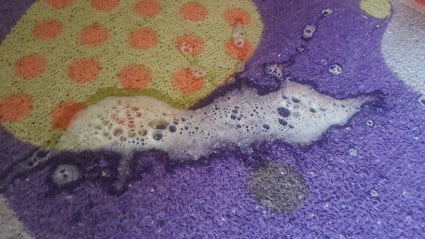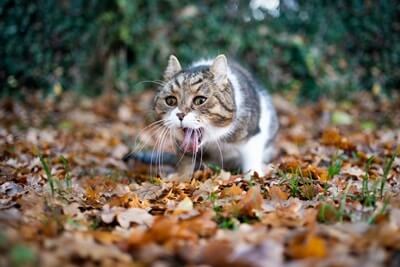Your cat bringing up white, foamy vomit can be an alarming sight. So, it’s important to determine if your cat is purging its stomach constantly or occasionally. Other related symptoms are also key to an accurate diagnosis.
White foam usually occurs because the cat’s stomach or intestines are inflamed. Furballs, parasites, and food allergies are common causes of inflammation. Occasionally, foamy cat vomit is linked to problems with other organs, such as the pancreas, namely pancreatitis.
To prevent your cat from vomiting white fluid, improve its gastrointestinal (GI) health (stomach and intestines). We’ll explore why most cases of foam vomiting in cats occur, what to do, and how to support a cat’s GI health.
Why Your Cat Is Vomiting White Foam
If your cat’s throwing up regularly, this isn’t considered normal. However, most cats will vomit occasionally, and throwing up isn’t necessarily a sign of illness.
Vomiting can sometimes be a behavioral issue, or it could be your cat’s way of expelling toxic substances.
Cats throw up for the following reasons:
Running Off Too Quickly After a Meal
This can happen if the feeding area doesn’t feel safe for your cat. Kittens may also run off too soon after a meal because they enjoy playing.
Eating Too Fast or Overeating
An underlying illness can sometimes cause overeating, but an irregular feeding schedule may explain the problem. If two or more cats share the same food bowl, they may eat their meals faster.
Eating an Indigestible Substance
Cats may throw up substances that their stomachs cannot process effectively. For example, cats eat grass, plants, and other vegetation for this reason.
Cats lack the right enzymes in their digestive systems to process grass, so they’ll regurgitate it. Some experts believe that cats eat grass to dislodge fur, bones, or residue from their stomachs.
So, cats throw up for various reasons, not just because they’re physically ill.

Should I Be Worried That My Cat is Vomiting?
Although occasional vomiting isn’t too concerning, seek treatment for your cat in the following scenarios:
- Your cat has been vomiting for more than 24 hours.
- Your cat is unable to eat or drink the day after vomiting. However, it’s normal for cats to refuse food for up to 12 hours after vomiting.
- Breathing difficulties.
- Your cat tries to vomit, but nothing comes out.
- Diarrhea and vomiting at the same time.
- Blood (brown vomit) or green bile in the vomit.
- Your cat is throwing up white foamy liquid, especially if it has occurred more than 3 times in 24 hours or has lasted longer than 24 hours.
If your cat is throwing up white liquid, it’ll need to be checked over by a vet. Many diseases and lifestyle factors can cause white foamy vomit, ranging in severity from mild to severe.
Why Is My Cat Throwing Up White Foamy Liquid?
Your cat probably has an issue with its gastrointestinal (GI) tract.
The GI tract consists of the mouth, teeth, tongue, pharynx, esophagus, stomach, small intestine, and large intestine. If any part of the GI tract becomes inflamed or infected, your cat may throw up a foamy white substance.
If your cat’s vomiting up white foam, your vet may diagnose gastritis or gastroenteritis. These broadly mean that a part of your cat’s GI tract has become inflamed or infected.
- Gastritis – This refers to an inflammation or infection of the stomach.
- Gastroenteritis – This refers to an inflammation or infection of the stomach and intestines.
GI problems can be acute (sudden and temporary) or chronic (ongoing). This means some instances of vomiting can be cleared up quickly, whereas others may require long-term care and prevention.
Gastrointestinal Tract Obstruction
Food and water must pass through the GI tract efficiently for your cat to stay healthy. If there’s an obstruction, your cat won’t absorb vital nutrients from its food and may become dehydrated.
Obstructions can form in the stomach (gastric outflow obstructions) or the intestines. If your cat develops an obstruction in its intestines, it may be due to intussusception.
According to AVCA, intussusception occurs when part of the intestine slides into the other, causing a blockage.
Here’s what causes blockages:
- Eating foreign bodies. Cats may swallow string, ribbon, and bits of plastic. Cat hair can also cause a blockage.
- Tumors (cancerous/benign) press on the GI tract and cause obstruction.
- A hernia
- Injury
- Parasites
If your cat’s obstruction is in the stomach and it’s unable to digest food, it may throw up hydrochloric acid in its vomit. This may have a mucus-like texture and will usually have a slight yellow tinge.
Obstructions in the intestines can cause foamy vomit, diarrhea, abdominal swelling, and lethargy.
Hairballs/Furballs
Cats groom themselves daily using their tongue, so some hair inevitably enters the gastrointestinal tract.
Most hair will pass through in your cat’s poop, but some may accumulate in the stomach. If too much hair collects in the stomach, this will lead to stomach inflammation.
When your cat’s stomach is inflamed, it’ll try to cough up the furball. Some furballs are difficult to bring up, so your cat may vomit bile or watery liquid for several days before the hairball makes an appearance.
Furballs can become lodged in the cat’s GI tract, causing an obstruction. You’ll need a vet’s assistance to dislodge the furball. This condition can become life-threatening if the obstruction isn’t removed quickly.
Although we think it is normal for cats to vomit up furballs, there’s limited evidence to suggest that feral cats have this problem. Coughing up furballs is probably not as natural as we think it is, so we should prevent this from happening.
Food Allergies
If your cat vomits due to an allergy, the vomit is often milky or foamy in texture because the stomach lining is inflamed. In addition to white foam, you may also see undigested bits of food in its vomit.
If your cat has an allergic reaction, you may see the following symptoms:
- Diarrhea
- Intensive scratching and/or hair loss on the head or tail
- Weakness and lethargy
- Cat acne
Other things can cause these symptoms, so it can be hard to diagnose food allergies. There is no reliable diagnostic test for allergies, but there are ways you can manage them.
Some common cat allergies include:
Cats tend to be allergic/intolerant to specific proteins rather than grain, though some cats are affected by grains. If you think your cat might be allergic to something in its diet, there are things you can do to help:
- Hydrolyzed Protein – Get a cat food that is made with hydrolyzed protein. This means that the protein has been broken down into small pieces making it digestible for most cats.
- Hypoallergenic Cat Food – There are cat foods made with fewer ingredients, so they are less likely to cause an allergic reaction. The manufacturers switch the allergenic ingredients for ingredients that the majority of cats can digest.
Notify your vet of dietary changes so they can monitor your cat’s progress.
Eaten Something That’s Toxic
If your cat has vomited white liquid several times in quick succession, there’s a chance that it’s eaten something toxic. Similarly, if it is gasping and heaving, but only a small amount of mucus is coming out, it might have ingested something harmful.
Many owners don’t realize how many hazards there are in and around the home. Cats can usually sense what’s edible, but that’s not always the case.
The following household products can be toxic for cats:
- Caffeine – We tend to leave bits of coffee or tea at the bottom of our cups. If you leave these cups lying around and don’t provide your cat with fresh water, it may start drinking your leftovers.
- Garlic and Onion – Most cats find it hard to process these vegetables. The consumption of spice is toxic to cats.
- Chocolate – Consuming chocolate can cause severe gastritis in cats.
- Alcoholic Drinks – Cats may drink an alcoholic beverage if it’s the only fluid available.
- Plants – Daffodils, foxgloves, and eucalyptus are common examples.
If your cat has ingested something toxic, you may observe additional symptoms such as hyperactivity, disorientation, yowling, or diarrhea.
Parasites
Many parasites enter the GI tract, especially the large and small intestines. According to Cornell, up to 45% of cats will experience ‘gastrointestinal parasitism’ during their lifetime.
The following parasites are most likely to cause vomiting:
- Roundworms – Roundworms live in the intestines, and they can grow to become very large if not treated. A cat with roundworms will have a voracious appetite. It will likely experience diarrhea and vomiting.
- Coccidia – Most cats will contract coccidia during their lifetime. However, if kittens develop it, they may start throwing up violently. A kitten with Coccidia can become dehydrated quickly without treatment.
- Fleas – Cats that have fleas are more likely to overgroom. The more they groom, the more fur will end up in their stomachs. It’s no surprise that cats with fleas often cough up more furballs.
- Stomach Worms – These are quite rare, but cats do get them. They can cause persistent heaving/gagging and foamy white vomit.
If parasites remain, they’ll lead to weight loss, a poor coat, and mood changes.

Irritable Bowel Syndrome
If your cat is vomiting white mucus and has problems going to the toilet (constipation, bloating, and diarrhea), your vet might diagnose Irritable Bowel Syndrome (IBS).
This condition occurs when the bowels become inflamed, but vets don’t always know why this occurs. IBS is a syndrome, so it’s a collection of symptoms caused by various factors.
The GI diseases (allergies, parasites, etc.) could lead to IBS diagnosis in some cats, especially if these diseases do not respond well to treatment. However, gastrointestinal issues do not always cause IBS.
Some scientists believe mental distress is one of the leading causes of IBS in cats. This makes sense because we know cats can become easily stressed if their environment is inadequate or they feel threatened.
So, if you want to prevent conditions such as IBS, try to create a calm and relaxing home for your cat.
Pancreatitis
Although most cases of vomiting are linked to the GI tract, vomiting can be a sign of pancreatitis (inflammation of the pancreas). The pancreas is a small organ, but it plays a key role in digestive health.
The pancreas releases a liquid that helps the cat digest fats, proteins, and carbohydrates. In some cases, the pancreas doesn’t release enough liquid (exocrine pancreatic insufficiency), or in some cases, it produces too much liquid (pancreatitis). If the pancreas produces too much of this liquid, it can seep back into the pancreas, causing inflammation.
Either way, issues with the pancreas will usually cause vomiting. They may vomit undigested food, mucus, and white liquid.
Scientists aren’t exactly sure what causes pancreatitis. Nevertheless, research suggests that ingesting insecticides, consuming too much fat in the diet, parasites, or physical trauma may cause pancreatitis in cats.
Cats with pancreatitis often become lethargic and refuse food, becoming dehydrated quickly. If left untreated, this condition can be life-threatening. As part of the treatment, your vet may prescribe enzymes to help your cat break down fats, proteins, and carbs in the GI tract.
Cat Is Throwing up Foam and Not Eating
Although vomiting foam isn’t always a sign of severe illness, it can lead to a secondary condition, such as dehydration.
According to the Blue Cross, you should care for a cat in the following way:
- If your cat throws up, remove all food for 12 hours but provide it with clean, fresh water. If it continues to vomit, has diarrhea, or becomes extremely lethargic, take your cat to the vet immediately.
- After 12 hours have passed, offer it 1 spoonful of cat food.
- If your cat eats this, keep offering it a spoonful every 2 hours until it has eaten a normal portion. Return to normal feeding the next day.
- If your cat cannot eat and drink anything 12 hours after it last vomited, or it has been vomiting on and off for more than 24 hours, an electrolyte imbalance and dehydration become a serious concern.
A dehydrated cat may start panting, have sunken eyes, and its skin may start to tent. You can check if your cat’s skin is tenting by gently pinching the skin at the back of its neck. If the skin does not ping back into place immediately, this suggests your cat is dehydrated.
If your cat occasionally throws up foam, this indicates poor GI health. While it is probably not life-threatening, you should take steps to improve your cat’s digestive health.

